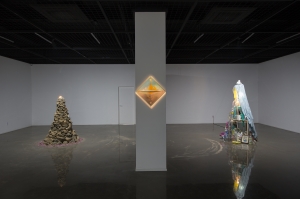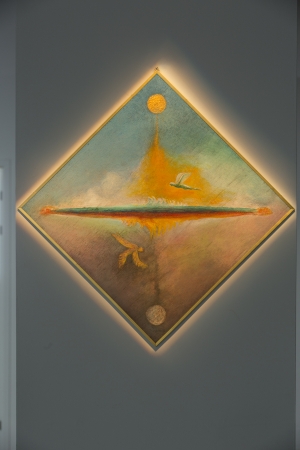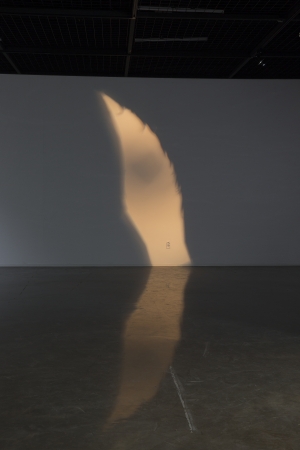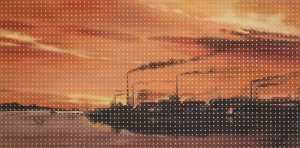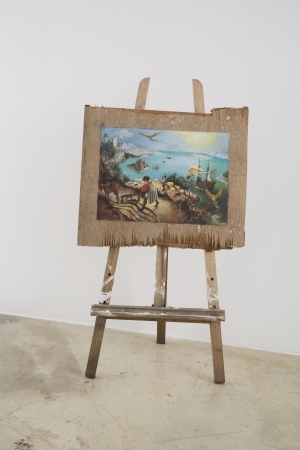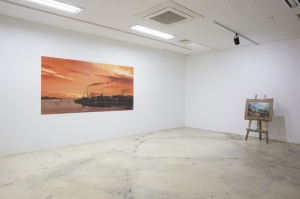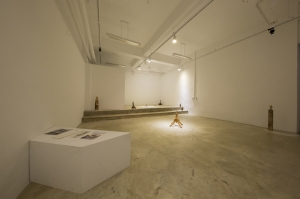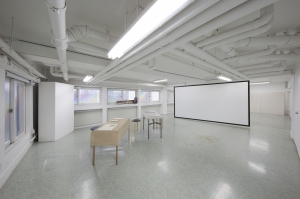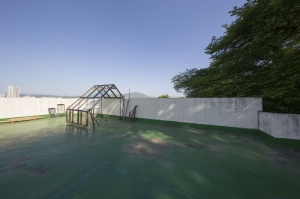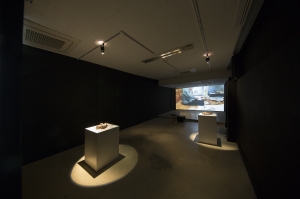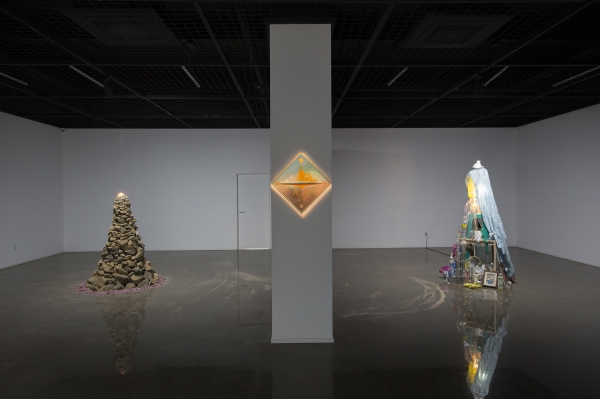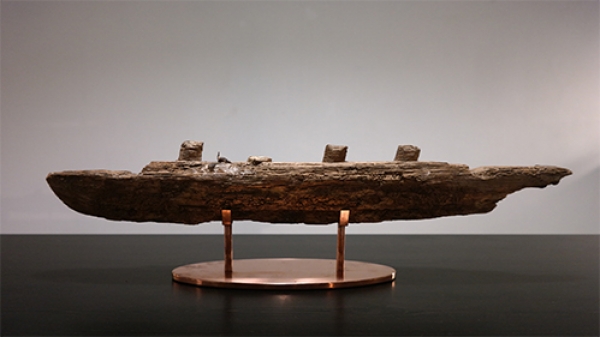전시 EXHIBITION
2Piece: 두 조각의 세계를 잇다
리혁종작가는 일대기적 작업의 연속선상에서 대전테미예술창작센터의 공간을 인근 장소 답사를 하고, 그 안의 자본주의 시스템 속 물질 순환이나 자신의 실존적 도약을 연계한 설치 작품으로 전시를 구성한다.
오누이 탑 (Two Towers)
오누이 탑은 인근 계룡산에 있는 두 개의 모양이 닮은 탑 이름이다. 이곳을 답사 후 영감을 받아 돌이나 플라스틱을 수집하고 쌓아올리려는 수행적 작품이다. 한 쪽 탑은 값이 없이 빌어온 공공재이자 자연재료의 하나인 돌로, 한 쪽은 폐기된 플라스틱 제품과 생활재 숍에서 사온 플라스틱 재질의 물건으로 구성된다. 플라스틱은 석유화합물의 시대에 대량생산제를 대표하는 재료로 이전에 인류에게 번영을 주었지만 현재는 처치 곤란한 폐기물이 되었다. 그러한 사회적 이면을 고려하여, 현장에서 가져온 돌과 그것을 플라스틱으로 복제한 작품이 위치한다. 두 재료의 유비는 결국 현대사회의 자연물질, 인공물질에 대한 감정, 감각, 인식을 대조하여 연결시킨다.
분산 배치
공간 구성을 분석하고 분산 배치하는 구성. 관람자는 여행자처럼 지도 속의 공간들을 찾아나서게 된다. 지층은 ‘미궁’으로 설정하고, 작가가 다시 재생시키고 있는 ‘이카루스 프로젝트’에 관한 작품, 정보, 영상 작업이 배치된다. 옥상에는 ‘테미 쉘터’ 작품이 현재 진행형 작업으로 배치된다. 에콜로지와 자본주의의 충돌을 유기적으로 완충·연결하고 더 나아가 자본주의를 넘어서는 예술을 찾아 나서는 모험과 여행인 셈이다.
2 Piece
표제 ‘2 Piece’는 이질적인 두 개의 장소, 차원_생태주의/자본주의, 자연/자본, 인간/자연, 동양/서양, 예술/삶 등_을 제시하여 연결하려는 은유적인 열쇠말이다. 아트북의 형식으로 한 영본 샘플이 제작되어 비치된다. 작가는 이를 매개로 ‘서양’에 진출하여 소통하며 운신의 폭을 넓히려는 야망을 책에 담고 있다.
-
생태의 바다와 자본의 태양 사이로 날기, 이혁종의 생태예술
미술평론가 유현주
근래에 테미예술창작센터의 옥상에 작가 이혁종이 완성한 작은 집 한 채가 있다. 버려진 물건들, 목재, 유리, 폐가구 등을 모아서 지어진 문 없는 이 집의 마치 현판처럼 보이는 판자 위에는 글씨가 쓰여 있다. 하얀 바탕에 검정 글씨로 쓴 삶은 옥수수(동료 작가와 ‘스위트 콘뮤니스트’로 팀을 결성하여 만든 프로젝트 작품)는 실제 옥수수 알갱이를 붙여 만든 것이다. 삶은 옥수수와 같은 것, 옥수수는 자연의 선물, 간식이자 식량, 심고 거두는 농사로서 노동과 땀의 결실, 화려하지도 비싸지도 않은 민중적인 소박함을 상징하지만, 무엇보다도 지극히 평범한 것으로서, 우리 가까이 존재하는 생명 곧 삶이다. 바로 그 삶의 예술로의 전환이 그동안 이혁종 작가가 추구했던 ‘삶과 예술의 비분리성’을 말해준다.
‘삶과 예술의 비분리성’은 그동안 작가의 공공미술의 궤적에서 구체적으로 확인된다. 그 주제의식은 대학에서 미술을 전공하던 시절부터 삶이 왜 예술과 별개의 것이어야 하는지는 ‘재료’에 대한 문제로부터 시작되었다. “나의 작업을 둘러싼 재료들은 어떤 경로로 나에게 다다랐으며 어디로 어떻게 돌아간단 말인가? 우리를 둘러싼 일상이 오염을 일으키는 물질들 투성이 아닌가?”라는 물음과 함께 보편화된 미술실천의 관념과 관습에 대한 저항과 실존적인 고민은 그로 하여금 자본주의의 반(反)생태주의적 삶과는 반대되는 ‘다른 생활’을 모색하게 했다. 제도권 미술 창작방식과는 다른 형태의 예술, 삶과 예술을 접목시키는 생활문화연구자 혹은 공공예술가로서 2010년부터 약 7년간 방아골 마을에서의 예술기획과 실천은 작가의 삶이 예술에 밀착되어 그 두 가지를 따로 떼어 놓을 수 없는 것이었다. 여기서 그 실천들을 일일이 이야기 할 수 없으나 중요한 사실은 그때로부터(그전부터도) 지금까지 자본의 잉여를 만들지 않고 자연을 훼손하지 않는 범위에서 선택해온 작가의 재료는 생태예술가의 철학이 반영된 고민이라고 하겠다.
작가가 올해 초 테미예술창작센터에서 열었던 전시 “2 Piece: 두 조각의 세계를 잇다”에서 선보인 재료들 역시 주로 버려진 목재나 유리창, 옷걸이 받침과 같은 폐가구들, 돌멩이, 자신의 머리카락과 짚을 엮은 것 등이다. 외양상 보잘 것 없는 재료들과 달리 전시 주제의 의미는 다소 무겁게 느껴질 정도로 거대담론을 녹여낸 화두이다. 이번 전시의 제목인 ‘두 조각의 세계를 잇다’를 통해 작가가 평소 껴안고 있는 삶과 예술에 대한 사유를 담아내면서 미학적 형식으로도 새로운 시도를 하려는 의지를 엿볼 수 있다. 2019년 현재의 시점에서 작가는 “거대한 미학적 매혹의 원천과 그것의 굴절, 부정된 식민지의 파편들 사이에” 역원근법적 관점을 투영한 작업을 한 것으로, 작가가 말한 것처럼 두 조각으로 상징되는 키워드 즉 “동양과 서양, 전통과 근대, 제국과 식민지, 자본주의와 공산주의, 자연물과 인공물, 요소들”간의 대립을 뛰어넘는 혹은 연결할 수 있는 가능성을 모색한 결과물이다.
세부적으로 보자면, 작가가 지층에 배치한 냉전양식 연구 회화작품 및 제국주의 미학과 식민지 참상 사이의 미술적 종합을 기획하였으며, ‘이카루스 재도약’이란 이름의 신화를 전유한 회화를 통해서 “동, 서 문화, 과거와 현재, 이념의 대립 등 관념과 감각의 거대한 간격”을 <이카루스의 재도약>이란 이름으로 연결하고자 하는 야심을 보여주었다. 먼저 그는 전시를 준비하기 전에 영감을 받은 장소 계룡산의 오누이 탑(Two Towers)을 재현하였는데 크고 작은 돌맹이를 정성껏 쌓은 돌탑과 플라스틱류의 재료를 쌓은 두 개의 탑으로 과거와 현재의 환경을 은유적으로 대비시켰다. 이는 대전이라는 장소특정성을 살짝 언급해주는 대목이면서 생태적으로 변화된 각각의 시대적 상황을 상징한다. 섬세하게 고안된 설치물을 보면, 돌탑 주변에 겹벚꽃을 놓은 것은 테미의 상징인 벚꽃이면서 자연친화적 삶의 과거를 상기시키고, 반대 편 플라스틱 탑 내부에는 3D프린터로 제작한 얼굴, 이카로스의 날개 등을 숨겨두어서 인공물질과 처치 곤란한 폐기물들(페트병, 종이컵, 버려진 의자, 탁자, 액자 등)로 넘치는 근대 즉 작가 자신이 속한 현재 인류세로 명명되는 시대 상황을 복합적으로 암시해주고 있다. 이러한 폐기물들은 사실 근대 과학의 발명을 은유하는 측면이 있다. 유리상자 안에 설치한 두 개의 돌맹이는 똑같은 모양과 색깔이지만 하나는 자연물이고 다른 하나는 기술로 제작한 인공물(과학)이라는 비유는 바로 인공탑과 연결된 사유의 흐름이다. 흥미로운 것은 이 탑들 뒤 벽에 이카루스의 거대한 날개가 그림자로 길고 크게 반사되어 있어, 전통과 근대, 자연물질과 인공물질 혹은 자연과 과학기술 시대 사이에서 발생하는 긴장과 갈등의 요소들을 어떻게 극복할 것인가에 대한 작가의 고뇌가 느껴진다.
정치적인 시각에서 이러한 갈등을 조명한 작업은 두 개의 손을 조각한 작업이다. 검은 손과 황금색 손, 로댕의 ‘손’ 조각에서 차용된 이 조각들은 서구 제국주의 나라들이 과거 식민지 콩고에서 수확물이 적은 사람들의 손목을 잘랐던 만행의 역사를 환기시킨다. 최근 비엔날레와 카셀 도쿠멘타에서도 여전히 다루고 있는 서구 제국주의 역사에 대한 비판과 반성의 작업이 이혁종의 작업에서도 반복되고 있는 것을 볼 수 있는데 이는 아도르노가 말했던 ‘죽음의 미메시스’로 세계의 고통을 예술언어로 드러낸 것이라고 할 수 있다. 아도르노에 따르면, 계몽이 다시 야만이 된 문명사의 변증법적 전개 속에서 이성이 개념으로 포섭함으로써 버려지고 배제된 것들을 구제하는 것은 유일하게 예술의 역할이기 때문이다. 개념과 사물의 동일성 사유에 속박당하지 않는 사유가 예술에서 가능한 이유는 대상을 개념으로 포섭하지 않고 반대로 대상을 친화적으로 모방(미메시스)하는 본능이 예술에서는 살아있기 때문이다. 따라서 예술은 자본주의의 물화된 것들에게조차 동화함으로써 역설적으로 현실의 현혹적 연관관계에서 배제된 비동일적인 것, 물화된 삶과는 ‘다른 삶’의 가능성으로서의 타자(das Andere)에 대한 구제의 요청을 할 수 있는 것이다. 이런 관점에서 작가가 재현한 손은 세계사의 고통이면서 ‘다른 삶’에 대한 희망의 패러디라고 할 수 있다.
이번 레지던시 기간 중 시도한 몇 개의 회화작품들은 제도로서의 미술에 도전하는 이카루스의 비상을 의미하기도 한다. 그 중의 하나 <금색 망점이 덮인 강선의 저녁 노을>은 1973년에 제작된 조선화(북한화)인 <강선의 저녁 노을>을 패러디한 것이다. 원래의 그림은 천리마 운동의 발상지인 강선에서 그 기상을 풍경화 형식으로 나타낸 대표적인 주체양식의 그림이었다면, 작가는 이 도상을 수집된 공사용 합판 위에 모사하고 그 위에 금색 망점을 덮었다. 작가의 말대로라면 “냉전 양식”탐구라는 의도의 이 그림이 남과 북 혹은 (시장)자유주의와 공산주의 사이의 예술 형식을 한 화면에 중첩한 새로운 양상의 회화일 것이다. 최근의 남북관계, 북미간의 정상회담이 이루어지면서 고무된 감정이 이 작품 속에 이입된 것을 볼 수 있다. 금색은 작가에게 자본, 서구, 근대, 제국주의, 자유주의 등을 상징하면서 양가적인 감성을 표출한다. 때문에 이카루스가 비상하면서도 너무 높이 올라가서 태양에 닿으면 날개가 녹아 추락하고 말 것이라는 위기의식을 갖는 것도 충분히 이해할 수 있는 논리이다. 한편 바다에 너무 가까이 가면 아예 도약할 힘을 상실해 버릴 수 있다. 삶과 예술을 이으려는 생태예술가로서의 이혁종의 주제의식은 지난날 방학동에서의 예술실천을 통해 자신의 신념으로 굳어져 확고하지만, 자신의 내면에서 꿈틀거리는 새로운 미적 실험과 도전 그리고 예술가의 자의식은 공공예술에만 묶여있기에는 한계를 갖는다. 삶과 예술의 비분리성에 대한 자신의 실험을 제도미술 안에서 어떻게 구현될 수 있는지, 생태의 바다와 자본의 태양 사이에서 힘찬 날개 짓을 하는 작가의 힘찬 도약을 기대해 본다.
To Fly between the Ocean of Ecology and the Sun of Capital: Lee Hyeokjong’s Eco-Art
Yu Hyunju (Art critic)
Lee Hyeokjong recently completed a small house on the roof of the Artist Residency TEMI. Letters are written on the board, which appears like a signboard, hanging on the doorless house built using junk, wood, glass, abandoned furniture pieces, etc. The phrase in dark letters written on a light background reads “Life is Corn” (a project by ‘Sweet Cornmunist,’ a team he formed with a colleague), was actually created by affixing corn kernels. Life is like corn. Corn is a product of nature, snack and meal, outcome of labor and sweat for planting and harvesting, and life that exists adjacent to us, which is neither fancy nor expensive, symbolizing the simplicity of common people and extremely plain. The conversion of this life into art signifies the ‘inalienability of life and art.’
‘Inalienability of life and art’ was demonstrated concretely in the artist’s past traces in public art. The theme was based on his question on ‘materials’ ? why life had to be separate from art ? raised while he was majoring in art as a university student. His resistance to and existential contemplation on the concepts and conventions related to universalized artistic practices, along with the questions “How have the materials surrounding my works reached me and how and where are they returning? Isn’t our daily life full of matters that cause pollution?” led him to pursue a ‘different life’ opposed to the capitalist anti-ecological lifestyle. He spent seven years starting in 2010 planning and practicing art in the Bangahgol Community as a researcher of living culture who combines life and art, seeking a type of art differentiated from the creation methods of institutionalized art, and a public artist, during which the artist’s life was so closely attached to art that his life and art became inalienable. It is difficult to enumerate his practices in detail, but what is important is that the materials he has been choosing from then on (and even before that) reflect the eco-artist’s philosophical efforts not to create capitalist surplus or cause natural harm.
Materials the artist presented in his exhibition “2 Piece: Connecting the Two Worlds ” held at the Artist Residency TEMI earlier this year were also abandoned wood and glass pieces, scrap furniture such as parts of coat hanger stands, pebbles, and pieces made by weaving his own hair and straw. Contrary to the shabby-looking materials, the exhibition theme represents a serious metadiscourse. The exhibition title ‘Connecting the Two Worlds’ suggests the artist’s will to embody his ongoing contemplation on life and art and make new aesthetic attempts. The artist created works by projecting inverse perspective “in between the source of enormous aesthetic fascination and its refracted and denied colonial fragments” as evident in 2019, which are the outcomes of the search for possibilities that rise above the conflicts or bridge between the keywords that can be represented as pairs, such as “East and West, tradition and modernity, empires and colonies, capitalism and colonialism, and natural objects and artificial objects.”
If we look more closely, he tried an artistic synthesis of paintings on the study of the Cold War style, imperialist aesthetics and colonial miseries, as well as revealed his ambition to connect “the immense gap between ideas and senses such as the Eastern and Western cultures, past and present, and ideological conflicts” through a painting implicating the myth of Icarus under the title Icarus Regeneration Leap. First, he recreated the Brother and Sister Pagoda in Gyeryongsan Mountain, where he got inspiration, in Two Towers. The work consists of an elaborate stone tower built by stacking big and small stones carefully, and a pagoda of plastic objects, to metaphorically contrast between the past and present environments. In addition to hinting at the place specificity of Daejeon, it symbolizes the ecological changes between two different periods. The exquisitely devised installation work consists of cherry blossoms surrounding the stone pagoda, TEMI’s symbol that recalls the nature-friendly past, and a face made using a 3D printer as well as Icarus’s wings hidden inside the plastic pagoda on the opposite side, suggesting the circumstances of the modern age, or the Anthropocene Epoch flooded with artificial objects and intractable wastes (PET bottles, paper cups, abandoned chairs, tables, frames, etc.), to which the artist belongs, in a complex way. These wastes actually allude to modern scientific inventions. Two stones installed in a glass box have the same shape and color, but one is a natural object while the other is an artificial object (science) made using human skills, and this is a metaphor representing the stream of thought related to the artificial pagoda. What is interesting is the large shadow of Icarus’s gigantic wings reflected on the wall behind the pagodas, giving a glimpse of the artist’s contemplation on how to overcome the elements of tension and conflicts arising between tradition and modernity, natural matters and artificial matters, or the age of nature and the age of science and technology.
His work shedding light on these conflicts from the political perspective is the sculpture of two hands. The hands in black and gold, borrowed from Rodin’s Hands, recall the history of brutality of the Western imperialist rulers, such as wrist-cutting committed on people who offered insufficient harvest in the colonial Congo in the past. We can see the criticism and reflection on the history of Western imperialism, which is still being pursued in leading art biennales and Kassel Documenta, being repeated in Lee’s works. This is the mimesis of death that Adorno discussed, which reveals the world’s pain using artistic language. It’s because, acccording to Adorno, in the dialectic development of the history of civilization, where enlightenment has reverted to barbarism, art alone plays the role of saving things abandoned and excluded due to the reason’s subsumption of them under concepts. Thought unrestrained by identity in considering concepts and things is possible in art because it has preserved the instinct to imitate (mimesis) objects in a friendly way, rather than subsuming them under concepts. Therefore, art can request the rescue on das Andere, or the other, as a possibility of a ‘different life’ contrary to the non-identical, or reified life, excluded from the bewildering relationship in reality, paradoxically by assimilating with reified things in the capitalist society. From such a perspective, the hands recreated by the artist represent the pains in world history and a parody of hope for a ‘different life.’
Some of the paintings he attempted during the residency period signify the leap of Icarus challenging institutionalized art. One of these, Evening Glow of Kangson, is a parody of a North Korean painting of the same title produced in 1973. While the original painting, which describes the spirit of the Chollima Movement through the landscape of Kangson, the birthplace of the movement, is a leading example of Juche style, the artist copied the image on a piece of plywood used for construction and covered it with golden halftone dots. According to him, the painting aimed at the study of “Cold War style” is a painting of a new style overlapping the artistic styles of South and North Korea or the (market) liberalism and communism on a canvas. We can see his emotion innerved by recent improvement in the relationship between South and North Korea and summit meetings between the US and North Korea in the painting. Gold color symbolizes capital, the West, modernity, imperialism, liberalism, etc. to the artist, and leads to ambivalence. Therefore, it is easy to understand the sense of crisis that Icarus, leaping and flying high, may burn his wings when touched by the Sun and ultimately fall. Meanwhile, he may lose the power to leap if he goes too near the ocean. Lee’s thematic consciousness as an eco-artist trying to connect life and art has been solidified through his artistic practices in Banghak-dong in the past, but has limitations because his new aesthetic experiments and challenges developing inside him, as well as the artist’s sense of identity, are restricted to public art. How can his experiments on the inalienability of life and art be realized within the boundary of institutionalized art? I anticipate his powerful leap, his wings flapping vigorously between the ocean of ecology and the Sun of capital.
- 기간
- 2019-05-02 ~ 2019-05-13
- 관련행사






